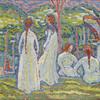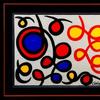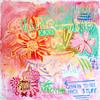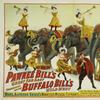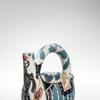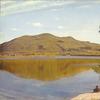San Francisco Art Institute Gets Save America's Treasures Grant to Restore New Deal-Era Frescoes
- SAN FRANCISCO, California
- /
- October 03, 2019
In the wake of a widely-publicized controversy that erupted surrounding massive 1930s murals at Washington High School in San Francisco, and a school board decision (now revised) to paint over them, comes another tale of murals in the city.
San Francisco Art Institute (SFAI) was awarded a $94,000 Save America’s Treasures grant to restore and conserve two major New Deal-era frescoes on the walls of SFAI's historic campus in the North Beach neighborhood.
The frescoes, which had been whitewashed and forgotten for decades, were rediscovered in late 2013 by SFAI’s VP of Operations & Facilities, Heather Hickman Holland, who noticed ghostly, web-like traces along the walls of a corner hallway. Upon closer examination, she realized that these marks were in fact outlines of figures and buildings. Through careful research of SFAI’s archives, Holland identified at least six of these “lost” frescoes throughout the building, with the positive identification of one of them—a delicate painting by Frederick Olmsted, Jr., titled Marble Workers (1935).
Marble Workers and a second fresco, known as Lost Fresco #6 until conservation efforts can identify the painter, are the subjects of the mural restoration and access plan made possible in part by the Save America’s Treasures grant, funded by the National Park Service, Institute of Museum and Library Services, National Endowment for the Arts, and National Endowment for the Humanities.
“SFAI played a central role advancing the fresco as an art form in the United States in the 1930s,” said SFAI President Gordon Knox. “SFAI faculty members brought Diego Rivera and Frida Kahlo to San Francisco for Diego’s first commission in the U.S., the incredible The Making of a Fresco Showing the Building of a City, which is open to the public seven days a week at our
800 Chestnut Street campus. Rivera’s presence in San Francisco stimulated the West Coast muralist movement. SFAI began to offer courses in fresco painting and turned classrooms and walls over to the exploration of the form. Nearly all of the 26 artists who worked on Coit Tower were affiliated with SFAI.”
“Making the ‘lost frescoes’ visible and accessible for the first time since the New Deal era will help further illuminate the stories, experiences and ethos of Bay Area public mural artists at an important time in our collective history,” Knox says. “This extraordinary project will allow students, faculty and visitors from around the world to experience the work in the context of other Social Realist murals of the time.”
Marble Workers, also called Marble Workers at Fisherman’s Wharf, was painted in 1935 after Olmsted, Jr., a grand-nephew of Frederick Law Olmsted, had completed his mural titled Power at the landmark Coit Tower on Telegraph Hill. The large, arched fresco, roughly ten feet high and nine feet wide, depicts a scene of everyday life in San Francisco, a group of nine men at
work at the Musto Marble Works just blocks from SFAI. The fresco is located in a well-trafficked corridor adjacent to what is now SFAI’s photography department. Marble Workers has been hidden from sight for roughly seventy years, most likely whitewashed in the mid-1940s. Its restoration, which includes overpaint removal, in-painting and fills, was launched with additional, earlier grants from the Henry Mayo Newhall Foundation and the NEA.
SFAI staff and conservators believe there is a good chance Lost Fresco #6 was painted by a woman, as were two other, extant SFAI frescoes by Marjorie Eakin (Sabre) and Eleanor Bates (Streloff). SFAI’s archive records show that Suzanne Scheuer, Una McCann, Ann Rice O’Hanlon, Margaret O’Keefe and, likely, Hebe Daum (Stackpole) also painted frescoes in the
hallways and cafeteria at SFAI. Lost Fresco #6 is the largest fresco on campus other than the school’s well-known Diego Rivera mural. Its location is exceptionally prominent, near what was previously the northern entrance to the campus, adjacent to the original cafeteria. This large painting (147” H x 142” W) was coated in urethane before being whitewashed, likely a misguided attempt to preserve the image.
SFAI’s research to discover why the frescoes were painted over is ongoing, but the situation is not unusual. Sometimes, overpaint is the result of miscommunication; a work order might be created to paint the interior walls of a building but neglect to specify which areas not to paint—resulting in entire walls painted over even if there is artwork on the plaster. It is also possible that the frescoes had some damage, and painting over them seemed a cost-effective and efficient response. Cultural depreciation may also have been a culprit; SFAI researchers speculate that when the Social Realist style fell out of fashion in the 1940s in favor of Abstract Expressionism, the perceived value of the frescoes may have temporarily shifted.





